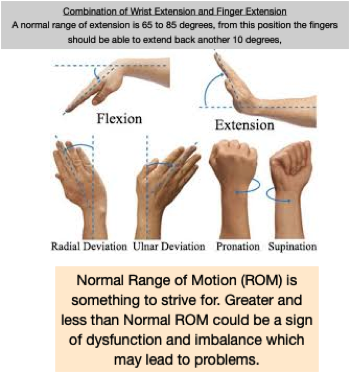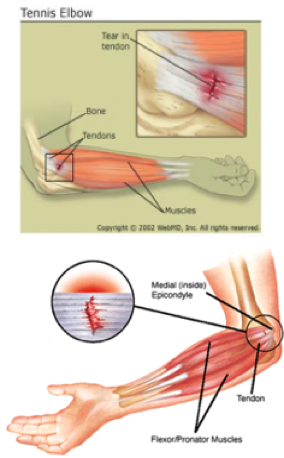Pain at the elbow could be caused from overuse from work, sport, and life as well as poor technique while doing physical tasks or inproper use of tools or sports equipment. You should seek out medical care if you have have pain and numbness or inability to fully extend or bend your elbow, but I feel that the following may help till you do get professional help. These suggestions will help prevent both tennis and golfer's elbow in many cases. Never do if they cause more pain or numbness. It is also a good idea to perform some of the basic exercises from our neck care program and wrist care programs because elbow pain is sometimes connected to the wrist and neck. All these exercises takes minutes a day and can be done almost anywhere. Studies have found that elbow splinting/bracing is very beneficial for those who have golfer's or tennis elbow with a forearm strap.
MORE DETAILS ON ELBOW PAIN adapted from WebMed: Lateral/medial epicondylitis, or tennis/golfer’s elbow, involves the muscles and tendons of your forearm. Tennis elbow, or lateral epicondylitis, is a painful condition of the elbow caused by overuse. Not surprisingly, playing tennis or other racquet sports can cause this condition. However, several other sports and activities can also put you at risk. Tennis elbow is an inflammation of the tendons that join the forearm muscles on the outside of the elbow. The forearm muscles and tendons become damaged from overuse — repeating the same motions again and again. This leads to pain and tenderness on the outside of the elbow. Golfer’s elbow, or medial epicondylitis, is the same as tennis elbow but affecting the flexors of the wrist of the medial aspect of the elbow. Many people with epicondylitis participate in work or recreational activities that require repetitive and vigorous use of the forearm muscle. See webmed : www.webmd.com
Epicondylitis From WebMed: Tennis elbow (also Golfers Elbow) is a types of tendinitis-- swelling of the tendons -- that causes pain in the elbow and arm. These tendons are bands of tough tissue that connect the muscles of your lower arm to the bone. Despite its name, you can still get tennis elbow even if you've never been near a tennis court. Instead, any repetitive gripping activities, especially if they use the thumb and first two fingers, may contribute to tennis elbow. Tennis elbow is the most common reason that people see their doctors for elbow pain. It can pop up in people of any age, but it's most common at about age 40.
The Causes of Tennis Elbow and Golfers Elbow
Tennis or Golfers elbow usually develops over time. Repetitive motions -- like gripping a racket during a swing -- can strain the muscles and put too much stress on the tendons. That constant tugging can eventually cause microscopic tears in the tissue.
Tennis or Golfers elbow might result from:Tennis (Golf for Golfer’s Elbow), Racquetball, Squash, Fencing and lifting weights. It can also affect people with jobs or hobbies that require repetitive arm movements or gripping. (see more at WebMD).
SELF TREATMENTS
As with any injury, your doctor will be the best source of advice on the appropriate treatment method for your situation. Immediate tennis or golfer's elbow pain management often begins with rest. Abstaining from activities that increase elbow pain helps give your elbow time to recover. Ice may also be used to help manage pain and inflammation.
Self Massage: If you had pain in areas during a palpation test you can try self massaging those areas for 1-3 minutes with moderate pressure using the pads of your fingers with a cross friction or circular stroke. If this increases pain stop. You can do this several times throughout the day. You can also do it with ice, but make sure you use a protective covering when doing so.
Splinting: Wearing a forearm strap can help alleviate pain caused by tennis or golfer's elbow and reduce strain on the joint. They can also help prevent it from reoccurring after it has healed. Proper placement is key. Usually just below the site of pain is where the bladder of the strap is placed ( the thickest part ). Consult the written direction that comes with the forarm strap.
Shake out your arms and do the drop arm exercise: You can shake out your arms lightly to stimulate blood flow and you can bend the arm as in a curl and then let it drop freely a few times to loosen your joint. BUT THERE SHOULD NOT BE PAIN.
Strengthening and stretching: Your doctor may also recommend physical therapy to help strengthen and stretch your forearm muscles.
Strengthening and stretching is the first line of defense in preventing carpal tunnel, wrist weakness, and epicondylitis.
Prevention and Exercise: There are a few ways to prevent carpal tunnel syndrome as well as epicondylitis. They are all centered around rest, form, posture, splinting, and exercise. It might not be a good idea to exercise the wrist area with carpal tunnel syndrome with pain. But if it is not present it is definitely a good idea to do the following exercises.
Elbow Care Program
Know Your Joints
SELF TESTS
Answer these questions and try these tests on yourself:
Normal Range of Motion of the Wrist and Elbow- similar to elbow section
Normal wrist and elbow range of motion is essential for both wrist and elbow health. Do these test on yourself. Both arms should be the same.
Wrist Bending
Forward bending of your wrist is called flexion. This motion is needed for daily activities such as styling your hair, writing, getting dressed, using a screwdriver and lifting heavy objects. Normal wrist flexion is approximately 70 to 90 degrees. Extension -- backward bending of your wrist -- is necessary for opening your car door, pushing a door closed, pressing up on the arms of a chair and driving. Normal wrist extension is approximately 65 to 85 degrees.
Wrist Deviation
Your wrist joint deviates -- or tilts -- from side to side. Ulnar deviation tilts your wrist toward the pinkie side of your hand. Radial deviation tilts your wrist toward the thumb side of your hand. These movements are used frequently during the day as you type, write, get dressed and talk on the phone. Normal ulnar deviation is approximately 25 to 40 degrees, while radial deviation is approximately 15 to 25 degrees.
Elbow Flexion and Extension
Normal elbow flexion is approximately 110 degrees from full extension, while normal extension is approximately 10 degrees from full extension. Compare sides. Both sides should be the same. If not try doing exercises to improve and seek out medical attention.
Where is the location of your pain? When it comes to epicondylitis there are common locations of pain. Palpate these areas on yourself to determine (see diagrams). Do you have pain in these locations? Also palpate the insertion of the triceps above the elbows. That area is commonly affected when the forearm is affected.
Swelling Test:
Do you have swelling? Swelling is a sign of inflammation. Check for swelling by measuring the girth of the forearm with fist clenched at maximum girth.
Resistance Test:
This involves extending your arm in front of you and placing your other hand on the back of the extended hand. Push against your hand as if bending it. Do your best to resist the force. The muscles near your elbow will provide what is necessary to resist the force you are applying. Therefore, pain means there is an issue. Was there pain with straight arm resistance?
The Chair Lift Test:
For this test, you will need a chair. You can use a normal chair, one that isn’t too heavy. Start off by straightening your arm and bending your wrist (your fingers should be pointing downwards). Lift the chair with your middle, index finger and thumb. Try not to use your pinky and ring finger in this test. Was there pain with chair lift?
Mid-finger Resistance Test:
In the next test you will need to start by raising your arm up with your palm facing away from you. Next, attempt to force your middle finger out of alignment with your second arm. There may be stress to the tendon and the extensor digitorum muscles, which in this case is a sign of tennis elbow. Was there pain with mid finger resistance?


Make an appointment with us either in person or online to talk about a conditioning program that is specific for you and possibly have a elbow range of motion assessment. Email us at fittec@me.com. Every body is different so every conditioning program must be designed to account for that.